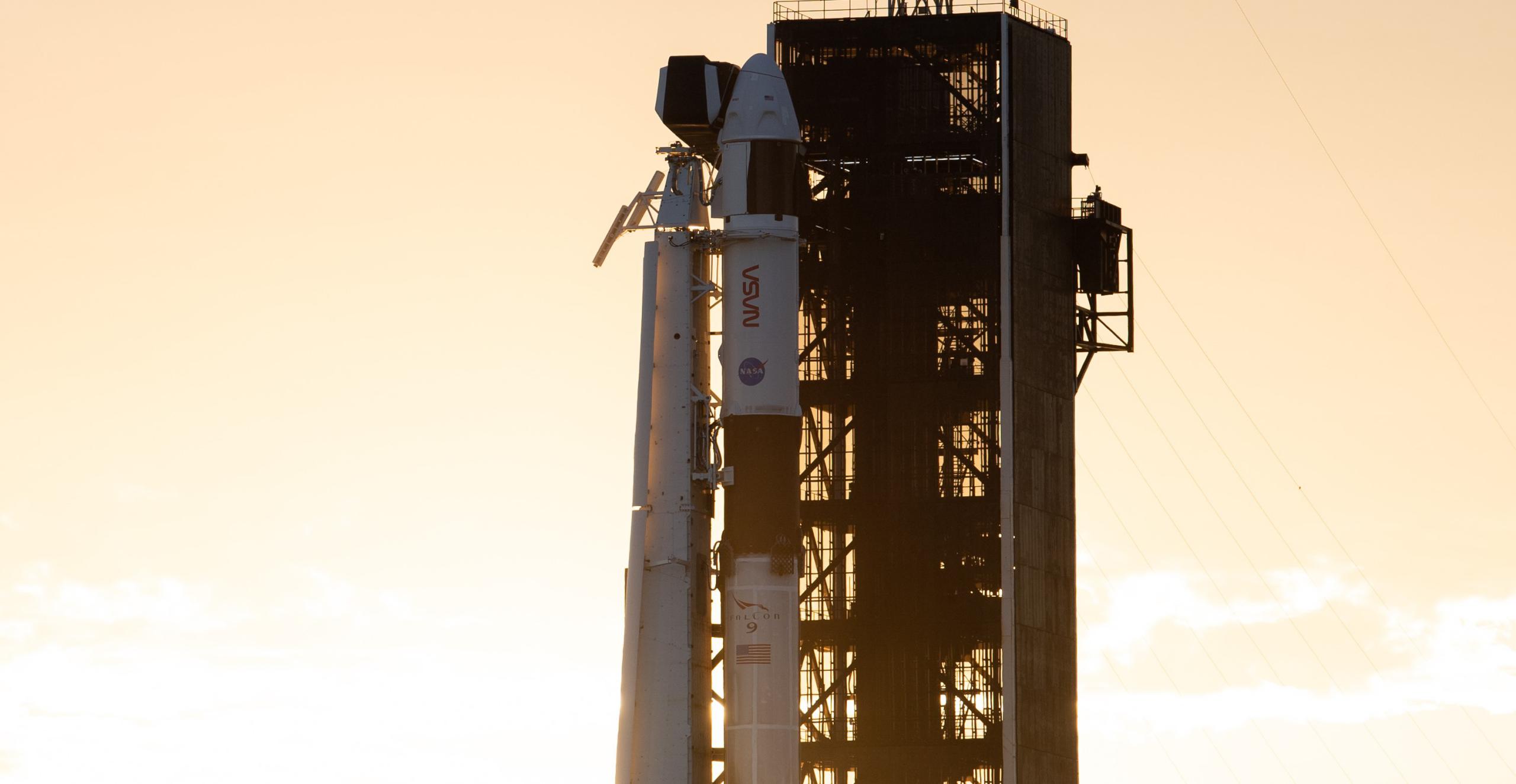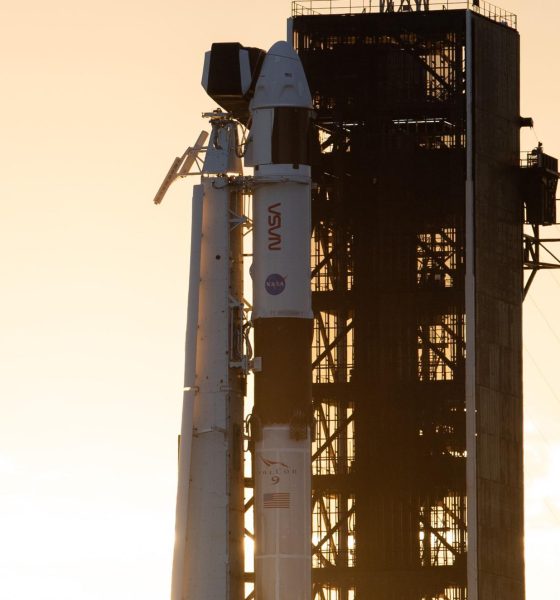

News
SpaceX astronaut launch slips into November
Update: A “minor medical issue involving one of [the] crew members” has forced NASA to delay Crew-3 a bit less than four more days from early November 3rd to 11:36 pm EDT (03:36 UTC), Saturday, November 6th. Falcon 9 and Crew Dragon are in good health and will remain vertical at Pad 39A.
Poor sea states and weather conditions along the Falcon 9 rocket’s ‘ascent corridor’ has forced SpaceX and NASA to delay their next joint astronaut launch from Sunday to Wednesday.
While conditions improved soon after, unfavorable orbital mechanics precluded backup launch windows on Monday or Tuesday, pushing SpaceX’s Crew-3 launch and crew rotation mission to no earlier than (NET) 1:10 am EDT (05:10 UTC) on Wednesday, November 3rd. Barring further delays, NASA astronauts Raja Chari, Thomas Marshburn, Kayla Barron, and ESA astronaut Matthias Maurer – all rookies save for Thomas – will ride a new Crew Dragon spacecraft into space atop once-flown Falcon 9 booster B1067 and a new, expendable Falcon upper stage.
Due to the delay, Crew-2 Dragon astronauts Shane Kimbrough (NASA), Megan McArthur (NASA), Akihiko Hoshide (JAXA), and Thomas Pesquet (ESA) will spend several more days in orbit than initially planned as they wait for Crew-3 to relieve them – hence the term “crew rotation.”
Crew-3’s delay means that for the second time in H2 2021, after launching 20 times in just the first half of the year, SpaceX hasn’t launched once in an entire month. Put simply, SpaceX’s internal Starlink launch cadence fell off a cliff in July and hasn’t recovered since. In H1 2021, 14 of 20 launches primarily carried Starlink satellites. With just two months left in the year, SpaceX has only launched one Starlink mission in H2 2021 and twice otherwise. Crew-3 will be the company’s fourth Falcon 9 launch in as many months.
It’s unclear just how much of that downtick has been a conscious decision made by SpaceX but odds are good that whatever is causing it is largely outside of the company’s control or, at least, is not intentional. One clear possibility is that SpaceX has run into significant issues while attempting to finalize, qualify, and mass-produce new space lasers designed to allow Starlink satellites to route communications without ground stations. So far, SpaceX has only launched one batch of 51 new Starlink V1.5 satellites, seemingly ruling out design or qualification issues. That leaves issues with production, which could potentially be hampered by widespread shortages currently affecting most manufacturing industries to some degree.
Most recently, SpaceX indefinitely delayed a second Starlink V1.5 launch previously scheduled in mid-October. According to launch photographer Ben Cooper, SpaceX has no other launches scheduled in November beyond Crew-3 and Starlink 2-3, both of which were initially meant to launch in October. In December, things could potentially pick back up, with NASA’s IXPE X-ray observatory, a European imaging satellite (CSG-2/CosmoSkyMed), Cargo Dragon’s CRS-24 resupply mission, and Turkey’s Turksat 5B communications satellite all scheduled to launch in the last month of the year.

News
Tesla FSD fleet is nearing 7 billion total miles, including 2.5 billion city miles
As can be seen on Tesla’s official FSD webpage, vehicles equipped with the system have now navigated over 6.99 billion miles.

Tesla’s Full Self-Driving (Supervised) fleet is closing in on almost 7 billion total miles driven, as per data posted by the company on its official FSD webpage.
These figures hint at the massive scale of data fueling Tesla’s rapid FSD improvements, which have been quite notable as of late.
FSD mileage milestones
As can be seen on Tesla’s official FSD webpage, vehicles equipped with the system have now navigated over 6.99 billion miles. Tesla owner and avid FSD tester Whole Mars Catalog also shared a screenshot indicating that from the nearly 7 billion miles traveled by the FSD fleet, more than 2.5 billion miles were driven inside cities.
City miles are particularly valuable for complex urban scenarios like unprotected turns, pedestrian interactions, and traffic lights. This is also the difference-maker for FSD, as only complex solutions, such as Waymo’s self-driving taxis, operate similarly on inner-city streets. And even then, incidents such as the San Francisco blackouts have proven challenging for sensor-rich vehicles like Waymos.
Tesla’s data edge
Tesla has a number of advantages in the autonomous vehicle sector, one of which is the size of its fleet and the number of vehicles training FSD on real-world roads. Tesla’s nearly 7 billion FSD miles then allow the company to roll out updates that make its vehicles behave like they are being driven by experienced drivers, even if they are operating on their own.
So notable are Tesla’s improvements to FSD that NVIDIA Director of Robotics Jim Fan, after experiencing FSD v14, noted that the system is the first AI that passes what he described as a “Physical Turing Test.”
“Despite knowing exactly how robot learning works, I still find it magical watching the steering wheel turn by itself. First it feels surreal, next it becomes routine. Then, like the smartphone, taking it away actively hurts. This is how humanity gets rewired and glued to god-like technologies,” Fan wrote in a post on X.
News
Tesla starts showing how FSD will change lives in Europe
Local officials tested the system on narrow country roads and were impressed by FSD’s smooth, human-like driving, with some calling the service a game-changer for everyday life in areas that are far from urban centers.

Tesla has launched Europe’s first public shuttle service using Full Self-Driving (Supervised) in the rural Eifelkreis Bitburg-Prüm region of Germany, demonstrating how the technology can restore independence and mobility for people who struggle with limited transport options.
Local officials tested the system on narrow country roads and were impressed by FSD’s smooth, human-like driving, with some calling the service a game-changer for everyday life in areas that are far from urban centers.
Officials see real impact on rural residents
Arzfeld Mayor Johannes Kuhl and District Administrator Andreas Kruppert personally tested the Tesla shuttle service. This allowed them to see just how well FSD navigated winding lanes and rural roads confidently. Kruppert said, “Autonomous driving sounds like science fiction to many, but we simply see here that it works totally well in rural regions too.” Kuhl, for his part, also noted that FSD “feels like a very experienced driver.”
The pilot complements the area’s “Citizen Bus” program, which provides on-demand rides for elderly residents who can no longer drive themselves. Tesla Europe shared a video of a demonstration of the service, highlighting how FSD gives people their freedom back, even in places where public transport is not as prevalent.
What the Ministry for Economic Affairs and Transport says
Rhineland-Palatinate’s Minister Daniela Schmitt supported the project, praising the collaboration that made this “first of its kind in Europe” possible. As per the ministry, the rural rollout for the service shows FSD’s potential beyond major cities, and it delivers tangible benefits like grocery runs, doctor visits, and social connections for isolated residents.
“Reliable and flexible mobility is especially vital in rural areas. With the launch of a shuttle service using self-driving vehicles (FSD supervised) by Tesla in the Eifelkreis Bitburg-Prüm, an innovative pilot project is now getting underway that complements local community bus services. It is the first project of its kind in Europe.
“The result is a real gain for rural mobility: greater accessibility, more flexibility and tangible benefits for everyday life. A strong signal for innovation, cooperation and future-oriented mobility beyond urban centers,” the ministry wrote in a LinkedIn post.
News
Tesla China quietly posts Robotaxi-related job listing
Tesla China is currently seeking a Low Voltage Electrical Engineer to work on circuit board design for the company’s autonomous vehicles.

Tesla has posted a new job listing in Shanghai explicitly tied to its Robotaxi program, fueling speculation that the company is preparing to launch its dedicated autonomous ride-hailing service in China.
As noted in the listing, Tesla China is currently seeking a Low Voltage Electrical Engineer to work on circuit board design for the company’s autonomous vehicles.
Robotaxi-specific role
The listing, which was shared on social media platform X by industry watcher @tslaming, suggested that Tesla China is looking to fill the role urgently. The job listing itself specifically mentions that the person hired for the role will be working on the Low Voltage Hardware team, which would design the circuit boards that would serve as the nervous system of the Robotaxi.
Key tasks for the role, as indicated in the job listing, include collaboration with PCB layout, firmware, mechanical, program management, and validation teams, among other responsibilities. The role is based in Shanghai.
China Robotaxi launch
China represents a massive potential market for robotaxis, with its dense urban centers and supportive policies in select cities. Tesla has limited permission to roll out FSD in the country, though despite this, its vehicles have been hailed as among the best in the market when it comes to autonomous features. So far, at least, it appears that China supports Tesla’s FSD and Robotaxi rollout.
This was hinted at in November, when Tesla brought the Cybercab to the 8th China International Import Expo (CIIE) in Shanghai, marking the first time that the autonomous two-seater was brought to the Asia-Pacific region. The vehicle, despite not having a release date in China, received a significant amount of interest among the event’s attendees.








